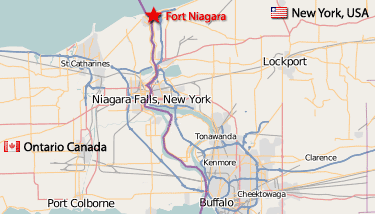|
|
Online Texts for Craig White's Literature Courses
|
|
|
selections from NARRATIVE OF THE LIFE OF MRS. MARY JEMISON
from CHAPTER V. |
location of Fort Niagara
|
[5.1]
When we arrived at Genishau
[Genesee river area, now in NY State],
the Indians of that tribe were making active preparations for joining the
French, in order to assist them in retaking Fort Ne-a-gaw (as Fort Niagara was
called in the Seneca language) from the British
[see map locating Fort Niagara above]
. . . . They marched off the next day after our arrival, painted and accoutred
[clothed]
in all the habiliments
[outfits]
of Indian warfare, determined on death or victory . . . . The British, feeling
themselves secure in the possession of
[5.2]
But on their way they were surrounded by the French and Indians, who lay in
ambush to deceive them, and were driven off the bank of the river into a place
called the "Devil's Hole" . . . . Not a single man escaped being driven off, and
of the whole number one only was fortunate enough to escape with his life. Our
Indians were absent but a few days, and returned in triumph, bringing with them
two white prisoners, and a number of oxen. Those were the first neat
[domesticated?]
cattle that were ever brought to the
[5.3]
The next day after their return to Genishau, was set apart as a day of feasting
and frolicking, at the expense of the lives of their two unfortunate prisoners*,
on whom they purposed to glut their revenge, and satisfy their love for
retaliation upon their enemies. . . .
some time in the month of November, 1759.
[5.4]
I spent the winter comfortably, and as agreeably as I could have expected to, in
the absence of my kind husband. Spring at length appeared, but Sheninjee was yet
away; summer came on, but my husband had not found me. Fearful forebodings
haunted my imagination; yet I felt confident that his affection for me was so
great that if he was alive he would follow me and I should again see him. In the
course of the summer, however, I received intelligence
[information] that soon after he left
me at Yiskahwana he was taken sick and died at Wiishto. This was a heavy and an
unexpected blow. I was now in my youthful days left a widow, with one son, and
entirely dependent on myself for his and my support. My mother and her family
gave me all the consolation in their power, and in a few months nay grief wore
off and I became contented.
[5.5]
In a year or two after this, according to my best recollection of the time, the
King of England offered a bounty to
those who would bring in the prisoners that had been taken in the war, to some
military post where they might be redeemed and set at liberty.
[5.6]
John Van Sice, a Dutchman, who had frequently been at our place, and was well
acquainted with every prisoner at Genishau, resolved to take me to
[5.7]
When my son Thomas was three or four years old, I was married to an Indian,
whose name was Hiokatoo, commonly called Gardow, by whom I had four daughters
and two sons. I named my children, principally, after my relatives, from whom I
was parted, by calling my girls Jane,
![]()



